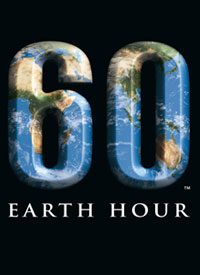
For the benefit of those unacquainted with this exercise in mass thought control, Earth Hour was the brainchild of the World Wide Fund for Nature (still known as the World Wildlife Fund — WWF — in the United States and Canada) and the Sydney Morning Herald in 2007. During the first event, 2.2 million residents of Sydney participated by turning off all non-essential lights. Copying Sydney’s example, many other cities in 35 counties around the world adopted the event in 2008. An estimated 4,000 cities in 88 countries took part in the 2009 dim-out.
“The primary reason we do it is because we want people to think, even if it is for an hour, what they can do to lower their carbon footprint, and ideally take that beyond the hour,” Reuters news quoted Earth Hour executive director Andy Ridley from Sydney’s Bondi Beach.
Earth Hour was enthusiastically received in Bonn, Germany, on the eve of a 175-nation meeting held to prepare a draft of a UN climate accord, a deal to be approved at the Climate Conference in Copenhagen, to be held from December 6–18. (See related article: “U.S. to Push for UN Global-warming Accord.”) WWF activists and conference delegates gathered in a candle-lit piano bar to bask in the aura of shared environmental consciousness as they awaited the next day’s conference.
“People want politicians to take action and solve the problem,” said Kim Carstensen, director of the global climate initiative for WWF. “Now we’re no longer so alone with our dream. We’re sharing it with all these people switching off their lights.”
UN Secretary-General Ban Ki-moon called Earth Hour “a way for the citizens of the world to send a clear message: They want action on climate change.”
Earth Hour’s name was undoubtedly inspired by Earth Day, an environmentally themed event that has been held on April 22 (coincidentally Lenin’s birthday) since 1970. However, the eco-fanatics behind the first Earth Day warned of a cataclysmic ecological disaster other than global warming — global cooling!
On April 19, 1970, just three days before the first Earth Day, University of California professor Kenneth E. F. Watt told an Earth Day gathering: “If present trends continue, the world will be about four degrees colder for the global mean temperature in 1990, but eleven degrees colder in the year 2000. This is about twice what it would take to put us into an ice age.” (Emphasis added.)
Watt explained that this temperature reduction was being caused by “the constantly increasing mass of smog-produced clouds all over the world.” His remarks merited inclusion in Earth Day — The Beginning, compiled by the group that coordinated the first Earth Day event and published later that year.
As to how the problem of an impending ice age morphed into dire predictions of global warming sufficient to end life as we know it on Earth, the answer is not scientific but political. From its beginnings, the Earth Day promoters advocated solutions to the environmental disaster-of-the-year. Solutions stressed population control, practical elimination of the automobile through draconian regulation and taxation, a drastic reduction in energy consumption by all people, an increase in national, state and local environmental laws, and the elimination of national sovereignty.
On Earth Day 1970, Saturday Review editor Norman Cousins bluntly stated: “Humanity needs a world order. The fully sovereign nation is incapable of dealing with the poisoning of the environment.” He asserted that “management of the planet … requires world government.”
Earth Day 1990 supported the “organization of a powerful international agency with authority to safeguard the atmosphere, the oceans and other global commons from international threats.” As if answering the unasked question concerning how the UN would enforce such environmental policies, the October 9, 1989 issue of Time magazine offered: “The stick could be a United Nations environmental police force deployed around the world to guard the planet’s most precious natural resources.”
Whether celebrating Earth Day or Earth Hour, however, there is a certain fanaticism associated with these eco-events suggestive of a religious cult. And the religion carries the hallmarks of a neo-pagan pantheism wherein man and nature are one, worshipping an Earth goddess.
Former Vice President (and global warming’s chief doomsayer) Al Gore once said that the task of “saving the environment” requires nothing less than a “transformation of the human spirit.”
Russell E. Train, chairman of the World Wildlife Fund that launched Earth Hour, has described the collectivist, pantheistic nature of the environmental movement: "Environmental ethics are rounded on an awareness that humanity is part of nature and that nature’s myriad parts are interdependent. In any natural community, the well-being of the individual and each species is tied to the well-being of the whole."
That description coincides closely with this definition of pantheism supplied by Wikipedia: “Pantheism: (literally "God is all" -ism) is the view that everything is part of an all-encompassing immanent God. In pantheism the Universe, or nature, and God are equivalent.”
Having been raised in a religious tradition that favors light over darkness (we speak, in the Nicene Creed, “Light of light, true God of true God”), this writer decided to celebrate Earth Hour 2009 according to his own belief system, by turning on every light — inside and out — for the hour!
We hope the message was illuminating!



